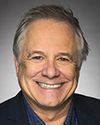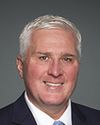Thank you to the steering committee members and you, Chair May, for this opportunity to provide testimony.
My earliest understanding of commemorating and respecting the sacrifice of those who serve came naturally growing up in Cape Breton. I know I'm not alone on this call today, Mr. McMullin.
My grandmother named her sons after family members lost in the First World War and had several brothers who served in the Second World War. In our community, men like Dr. Mike Laffin never spoke of their service, when their heroics were undeniable and often spoken of by others.
My father joined the effort to restore the World War II installation in New Victoria as a tribute to these service members. Fort Petrie remains there today. The founding members of that volunteer committee still operate it as a seasonal museum on one of the most beautiful stretches of coastline in North America, but I am biased in that, I think.
Remembering where you come from is baked into your DNA in Cape Breton, which stays with a person for life, no matter where you call home.
A little more than seven years ago, while having coffee with a colleague, she mentioned something that resonated very deeply with me. “Do you know that thousands of Canadians all went to war from right here?” We were sitting just a stone's throw away from the Halifax harbour. Of course, we all know that the Canadian Armed Forces have a long and proud history in Halifax; however, it had never occurred to me that thousands of those who lost their lives in the Great War in fact took their last steps on Canadian soil on the Halifax waterfront. It was a profound realization for both of us as we sat there. The images of the feelings of people, not far from where we were, saying their last or forever goodbyes weighed heavily on both of us.
There was no big event, no marker of this particular place as a sacred ground that captures the far-reaching impact of those goodbyes. Thousands of people would visit the Halifax waterfront and leave, not knowing of this significance outside of it being a tremendous tourist destination with proud Maritime traditions and also historically connected to one of the largest man-made explosions which, of course, only happened because of the city's pivotal role in the Great War. Those are dots that are not always connected for everyone, including our kids who are in grade school.
War museums around the world do this on such a grand scale. Here in Halifax, I felt that we also had sacred ground for the nation that we could mark. We all felt, as sort of an ad hoc committee that we formed, that it should be acknowledged in some meaningful way.
Initially I was told that the government didn't do monuments or infrastructure any longer, so we collected, or re-collected, ourselves, and we thought perhaps we could stage a re-enactment of troops marching from the armoury to the Halifax waterfront, as they would have 100 years ago, to mark the centennial. That idea was rife with problems and logistical issues, and we ran out of time.
Then, on meeting some local military historians, I was introduced to Ken Hynes, curator at the army museum in Halifax Citadel. I shared the idea of somehow marking these last steps. We talked about trying to do something, anything that was low cost, that we could practically shoulder ourselves as volunteers.
Then there was a conversation I had with Nancy Keating, a dear friend, a well-known artist and someone with a very proud history of family service. In an instant, she seemed to elevate the entire discussion, literally and figuratively, and began sketching at that table what would become the Last Steps Memorial Arch that stands on the Halifax waterfront today.
It was at this point that it seemed possible, but even the most modest of ideas took what felt like a Herculean effort to get people to see how easily this could be and why it was so important for so many.
One of those people was Andy Fillmore, in his previous tenure in the province of Nova Scotia. He and his colleagues seemed to embrace this idea without reservation for what felt like the first time in all of the discussions we were having. I had always held the centennial of the departure of the 25th Battalion from the Halifax waterfront in May 1915 as an artificial deadline for kind of giving up trying to do something. It was fast approaching May 2015, and you don't get another chance at a centennial—or I don't think anybody's figured out that science yet.
Nancy then developed a conceptual drawing of an arch reminiscent of the gangways that connected the ocean liners seconded into service during wartime, as well as the historic victory arches of Europe. The illustration was breathtaking. Pier 21, Parks Canada and so many people and organizations could really see the vision now. It was something that was understated but powerfully meaningful with just three words that said it all: The Last Steps.
We unveiled the concept on the centennial of that fateful departure. However, we did not have one cent committed to the build. You could call it a gamble, I guess, but we believed others would see the importance, and they did. Halifax Foundation, the City of Halifax, Develop Nova Scotia—all supported the idea instantly. We did come to find out that the federal government would support maybe not the type of infrastructure that others maybe thought, but this was modest enough, I think. They became an anchor funder through ACOA.
Concurrently with this, I was introduced to some visiting representatives from Belgium. I shared with them the idea of our Last Steps. It seemed so small to them, as their country is just steeped with memorial tourism and is peppered with monuments, but they were on our team. They remained supportive from afar and we stayed in touch. I was able to visit them many times. I would learn that over 30,000 of our war dead are buried in Belgium. I could see first-hand how their graves are cared for and their stories are cherished. I wish every Canadian had the opportunity to visit these battlefields and the scarred but beautiful countryside of Flanders to feel that kind of pride. There's nothing like it.
Because of this, The Last Steps now has a sister arch in Belgium called Canada Gate, also of Nancy Keating's design. It is proudly in Passchendaele, the very place where Canadians fought in one of the most costly battles in our nation's history.
None of this would have been possible without the Army Museum, Major Ken Hynes, and so many bright lights along the way who kept pushing and putting one foot in front of the other. At times, I simply felt like a witness to it all. Whether it is The Last Steps, a ceremony, or a virtual event, the act of remembering, no matter how hard it may seem, can never compare with the service and sacrifice of our forefathers and mothers. These projects are worth doing for everyone, every year, and for every story there is to share. They are all sacred. Canadians have left an indelible mark around the world. It is our responsibility to uphold their memory in creative but, more importantly, meaningful ways.
In closing, two years ago I was given the greatest honour of my life when I was appointed as honorary lieutenant-colonel for the Halifax Rifles. It came as a great surprise. My learning curve continues to be quite steep. However, I have absolutely noted that for the men and women in my unit, seeing a nation that does not forget where it comes from can sometimes be payment enough. But we know that we can always do better. Our regimental motto is Cede nullis—yield to none. As a country, the least we can do is to be unyielding in our gratitude and in our support of those who serve today and to meaningfully commemorate the service of those who have passed.
Thank you, Mr. Chairman.










